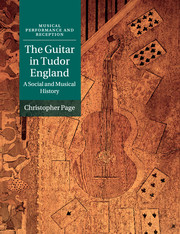Book contents
- Frontmatter
- Dedication
- Contents
- List of figures
- List of tables
- List of music examples
- Acknowledgments
- Note on music examples
- List of abbreviations
- Introduction
- 1 Imagery
- 2 Who owned a gittern?
- 3 The gittern trade
- 4 ‘An instruction to the Gitterne’
- 5 Sounding strings
- 6 The gittern and Tudor song
- 7 Thomas Whythorne: the autobiography of a Tudor guitarist
- Conclusion
- Appendix A The terms ‘gittern’ and ‘cittern’
- Appendix B References to gitterns from 1542 to 1605
- Appendix C The probate inventory of Dennys Bucke (1584)
- Appendix D Octave strings on the fourth and third course
- Appendix E The fiddle tunings of Jerome of Moravia, swept strings and the guitar
- Appendix F The mandore and the wire-strung gittern
- Appendix G The ethos of the guitar in sixteenth-century France
- Appendix H Raphe Bowle
- Bibliography
- Index
2 - Who owned a gittern?
Published online by Cambridge University Press: 05 June 2016
- Frontmatter
- Dedication
- Contents
- List of figures
- List of tables
- List of music examples
- Acknowledgments
- Note on music examples
- List of abbreviations
- Introduction
- 1 Imagery
- 2 Who owned a gittern?
- 3 The gittern trade
- 4 ‘An instruction to the Gitterne’
- 5 Sounding strings
- 6 The gittern and Tudor song
- 7 Thomas Whythorne: the autobiography of a Tudor guitarist
- Conclusion
- Appendix A The terms ‘gittern’ and ‘cittern’
- Appendix B References to gitterns from 1542 to 1605
- Appendix C The probate inventory of Dennys Bucke (1584)
- Appendix D Octave strings on the fourth and third course
- Appendix E The fiddle tunings of Jerome of Moravia, swept strings and the guitar
- Appendix F The mandore and the wire-strung gittern
- Appendix G The ethos of the guitar in sixteenth-century France
- Appendix H Raphe Bowle
- Bibliography
- Index
Summary
Item by estimation iiij oz. of broken silver
Item a gitterne
Item xij paier of sheates and one sheate
Inventory of Dennys Bucke (1584)Visitors to the house of Dennys Bucke, a yeoman in the Norfolk village of Great Walsingham, might catch the sound of a gittern beneath the cries of the geese that were loose in his yard. A few decades earlier, prisoners taking exercise in the Tower of London, or sitting by an arrow-slit window, could hear the sound of a fellow captive playing the gittern. More such scenes can be recovered, or legitimately imagined, for after 1550 references to the gittern begin to multiply in many kinds of literary and archival records. (These references are calendared below in Appendix B, to which the reader is referred for details of all dated citations in this chapter.) Read in broad context, this increase of material reflects a rise in the volume of maritime trade that brought many new commodities, including gitterns, to the Port of London. The mounting output of shipyards in London, Ipswich and elsewhere during the later 1550s testifies to the health, in England, of what has been called ‘the modern, novel and innovative sector’ of most European economies during the sixteenth century. Those in a position to benefit purchased imported looking-glasses, desks, perfumed gloves, musical instruments and many other commodities on a scale probably unknown, in many cases, to their grandparents. The prominence of the gittern in written sources after 1550, relative to the half-century before, also reveals the special place that this portable, relatively inexpensive and companionable instrument had earned, together with the cittern, in a literate amateurism that began to gather strength in the 1500s (see Chapter 4). As a result of both developments, maritime and musical, even university men ceased to be the impecunious clerks of Chaucer's imagination, with no possessions save their books. A student who entered Trinity College, Cambridge in 1564 possessed ‘a gitterne in a case’ when he died, carefully kept with other valuables that included two small gold rings and a silver spoon (Appendix B, 1605).
The seminal period for the introduction of the gittern into England lies in the years around 1550.
- Type
- Chapter
- Information
- The Guitar in Tudor EnglandA Social and Musical History, pp. 31 - 59Publisher: Cambridge University PressPrint publication year: 2015



